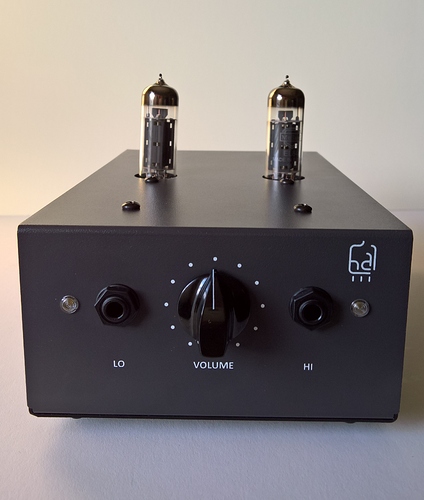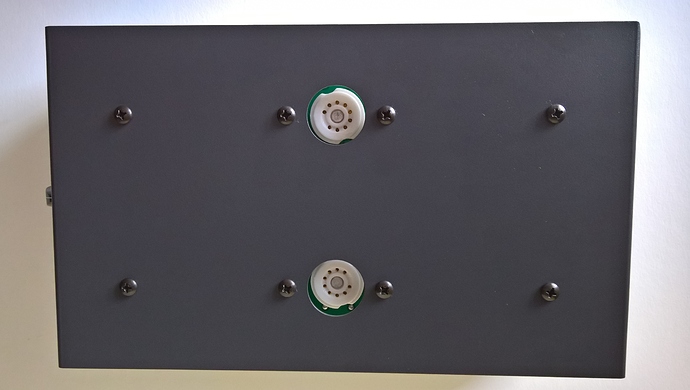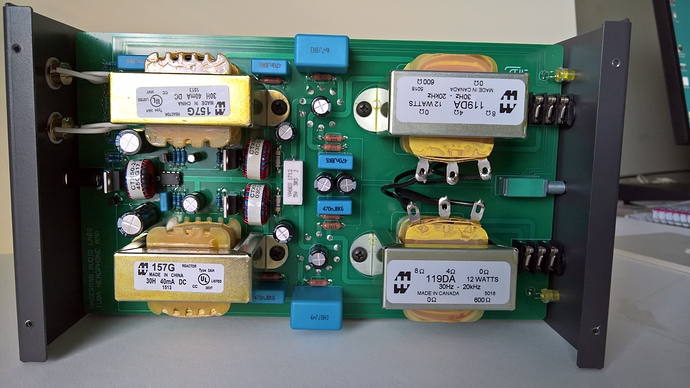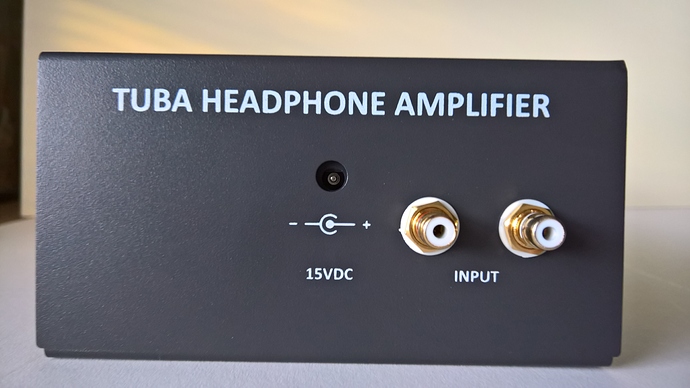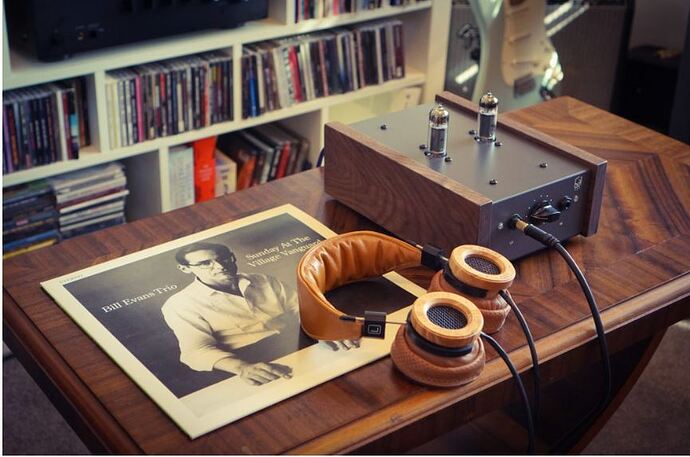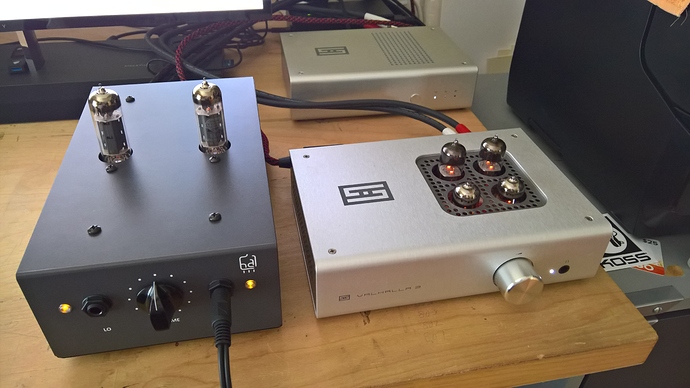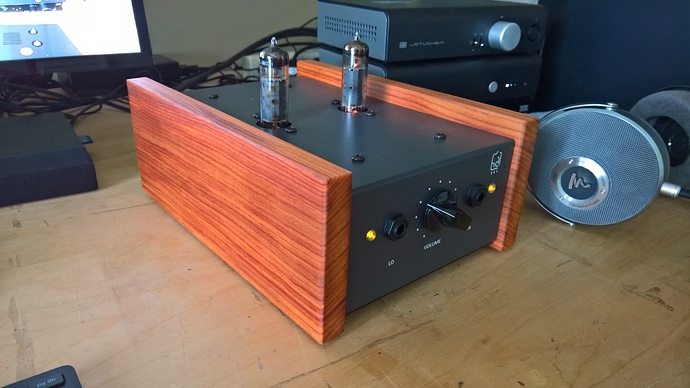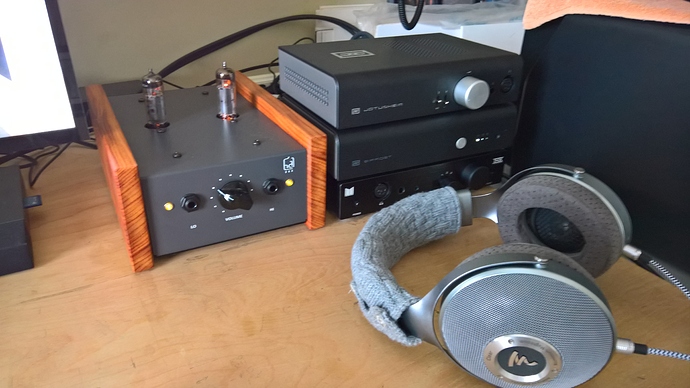I reviewed this amp a few months ago, and liked it alot. After having it for a few days I had t send the demo unit back to Jim in Hawaii. I have 12 amps here at the moment including several tube and SS amps. Lots of headphones etc. I really missed this amp and recently sold my BH Mainline to fund this purchase!
It arrived yesterday and its like an old friend has returned for a beer and pizza! LOL.
Its a stunning simple but refined parafeed amd that used two EL84 or 6BQ5 tubes, I a have newly re-issued Mullards and a glden set of Mullards from Great Britain from the original Mullard factory. Those NOS $199 tubes!
Here is my original review:
I was recently contacted by Jim Hagerman from Hagerman Audio Labs in Honolulu, Hawaii and Jim asked me if I would like to try his new TUBA headphone amplifier. How could I refuse!
Well being an old tube guy remembering my electricity (yes electricity) class and labs where we had to draw load lines and build vacuum tube circuits I have a fond love for all things with vacuum tubes.
So at first I checked in with the admins to make sure it was ok to do a review or what I like to call an “experience”
So its with FULL disclosure that this headphone amp was sent to me with no solicitation by me whatsoever, and the amp will return to Jim after I have had a chance to use it and make some comparisons to the head amps I have in house. I have no special deals with Hagerman Audio Labs.
To be honest I have never heard of Jim or his small enterprise in Hawaii. There are a few
reviews out there that are referenced on Jim’s website and they all are pretty positive.
Matty at Headphonia, Bob Levi at Positive Feedback and Trav Wilson at Headphonesty are the three that are referenced.
The specifications listed at Hagerman Audio Labs :
50K Input Impedance
5/35 ohm output impedance (LO/HI)
10HZ to 150Khz bandwidth (-3dB)
350mW @ 32 ohms
7Vrms output voltage
5dB gain
0.25% distortion @ 0dBV 400Hz
6 x 10 x 3.inches
15 Vdc@ 1.35A
EL84 x 2
The TUBA is designed to operate with either low impedance (ie Grado type) or high impedance (ie Sennheiser type) headphones. This IMO is a good thing, with the OTL and Non-OTL amps out there, some amps only work well with high impedance headphones, like the Bottlehead Crack, which I own. You need to start getting into the more high dollar headphone amps with output transformers to handle wildly differing impedance’s. The TUBA has (2) 1/4" headphone jacks on the front, one marked “LO” the other marked “HI”. Simple enough.
Simple and straightforward. There are two small lights on the front panel. To turn on the amp you have to press the VOLUME knob inward and the light on the left comes on immediately, then 30 seconds later the high voltage fires up and the light on the right comes on indicating your ready to listen. Of course you can elect to wait until all is warmed up or start right in listening…
The Tuba is designed around EL84 tubes used in a single-ended, zero-feedback, parafeed triode arrangement. A matching output transformer (OPT) offers low distortion and high signal headroom, and supports high or low impedance headphones with dual outputs. Two different taps on the OPT secondary offer two output impedance levels: 35 ohm for High impedance headphones, 5 ohm for Low impedance headphones.
Some may not know or care what a parafeed amp is all about, but there have been several out there, one comes to mind is the The ECP Audio / Beezar Torpedo Headphone Amplifier. This amp had some warts, noise etc…the Tuba is totally free from any noise. Jim posts a complete schematic of the amp online in the downloadable Tuba users manual.
I asked Jim about the LO and HIGH outputs and he replied “LO can drive virtually anything. Sometimes I use it for HD600. For HI I would suggest anything 120 ohms or higher.” Also when the Tuba first came out there was a crossfeed circuit built in and this has been removed for recent and future builds. Jim will remove this circuit for those that have it installed in prior units. One reviewer mentioned that if Jim had not mentioned this circuit to him he might have not noticed it at all…its a thing that unless you have certain earlier recordings (mono etc) you may never hear any differences. The good thing here is by removing this circuit there is the added benefit of several more dB gain no longer being chewed up with the crossfeed filter. Jim uses Sundras (and others) and they dont get super loud but stay well controlled. But if you want this feature Jim will also install it!
The Tuba has one pair of small pentodes run in triode mode, using half the internal elements per channel. The EL84 is a rugged tube, with long life and a sweetie of a sound. It is considered by many the best and most musical pentode ever built. Transformers couple the tube to both the inputs and outputs, yielding a very powerful and simple circuit. It is also extremely quiet, making IEM use a perfect application.
I took off the covers (4 screws) and inspected the internal build. I have built many circuits over the past 40 years of being a electronics , many commercial and many DIY…I can tell easily when I look at a layout if the construction is well done or not. The layout and build is exceptional IMO. Simple. Symmetrical, great soldering, Hardly any spaghetti wiring found in many tube amp chassis. The only wires I saw are the output transformer wires and the left and right input jacks to the pcb. On the opposite or top side of the pcb there are only the two ceramic tube sockets. that are soldered directly to the pcb. THIS IS GOOD!
Why? Because when you insert and remove tubes with some “less” expensive tube sockets the rocking back and forth may cause a fracture in the solder joints below and cause issues…many kit builders experience this. So when you plug in a tube in the Tuba its solid and the connection is very good…again nice job here Jim!
The design is reminiscent of retro laboratory or industrial equipment. It’s a heavy dark aluminum case with minimal white lettering and a pointed plastic knob. The look is aggressively understated. No polished wood, no polished aluminum, and a bare minimum of switches and controls, means that the Tuba isn’t for those looking to visually impress. It weighs 7 lbs and looks like a tank could run over it and it would survive!!
The rear panel is minimalistic: A jack for input power and two RCA input jacks:
Many us when we spend our hard earned or saved retirement dollars like to get our moneys worth when it comes to equipment. The TUBA headphone amp looks like its a very well designed amp that might just meet many of our expectations…lets see.
At first looks it seems like a very basic looking tube amp, boxy, kind if austere looking, with not many knobs or buttons to play with. Its an amplifier. Looking at the picture, you see the 2 headphone jacks, and what I call “an old fashion” volume knob, with the word “VOLUME” underneath it!
There is a 15Vdc wall-wart power supply that the unit gets its input power from. The power stage is a single-ended parafeed EL84 triode into and impedance matching transformer, offering low distortion and huge signal headroom. An internal switching power supply boosts the 15Vdc input by a factor of ten for B+, after the 30 second warm up delay. To turn the amp off you simply press the VOLUME knob inwards.
The amplifier retail for $649, and includes the power supply, tubes and free shipping. There is a $50 option to include Walnut side panels to dress it up abit. Which IMO are really nice.
This Pix courtesy of Headfonia.com
So how does it “work”?
In short: Well, very well.
You may have noticed that Jim uses instrument names for his creations: Trumpet, Tuba, Bugle, Cornet, Piccolo, etc. This likely harkens back to Jim’s childhood where he grew up playing trumpet in the school jazz band and orchestra.
I have read that Jim stated that he was not trying to make the amp sound like anything…I like that. he El84 tube was selected with the end user in mind, readibly available and lots of NOS selections. The EL 84 is often decribed by tube folks as having a tight tonal characteristic, a strong warm midrange focus and rich dynamic harmonics…whatever the magic is its working nicely with the Tuba.
The EL84 provided by Jim were Mullards. I did not have any real special NOS tubes to try other than what was provided. They werent too shabby at all.
I listened at first with the Focal Clears…and the first impressions was “WOW” this is a very nice tube headphone amplifier.
I used the LO output for the 55 ohm clear and it is a very, very nice paring…the Clears were absolutly wonderful with this amp.
Clean and articulate…after 30 or songs I brought out the Bottlehead Mainline and let it warm up for an hour and set the levels on both with my trusty Radio Shack SPL meter at 75dB.
I have a Schitt MB Bifrost DAC with their new Unison USB interface and all the music is ripped Redbook stuff. Having the amps side by side its a really quick switch between the two, barely 2 seconds, and the key to this for me is getting the level set as close to one another as you can…even with only such a short time with two very good amps its hard to discern things…
Well after an hour of this testing back and forth, the Mainline has a fuller sound…musical and nice, but a bit more bass or heft. The Tuba sounds more clear or precise but still with a wonderful musical sound. Compared to the Tuba the Mainline sounds a little congested at times, while the Tuba was just clear and articulate…easier to listen to and thats saying alot, I really like the Mainline, but the Tuba is no slouch here, it punches right up there and then some.
When cranked up full volume on either of the outputs the Tuba is dead silent. I think this really quiet black background attributes to the Tubas wonderful clarity. The upper end or registers are just reproduced so tonally accurate, even more clear than the Mainline. The amp is not boomy on the low end either. Strong clean and tight bass, if its there it comes out, and its more dependant on the recording your listening to…
Power wise with the Focal Clears, no issue at all driving them to ear shatterng levels with the LO output. The Beyerdynamics T1 R2’s at 600 ohms were used in the HIGH output and again no issue driving them to ear shattering levels. One review stated that the Tuba didnt have the power to really make the T1’s sing, I found that to be untrue. That said the Mainline has more power output for sure. But I dont think this is a real issue with the Tuba at all.
Next up were the Sennheiser HD600’s at 250 ohms in the HIGH output jack. This time around the HD600s sounded kinda of thin than with the Mainline. The Mainlines throatie-ness seems to add to the HD600s and make them more warm than dry…this varies with the source. The Tuba IMO is a very neutral tube amp, while the Mainline seems to add just a little softer sound in the midrange…either one is nice, but the Tuba is just clearer IMO. The HD 600’s after several hours with them come across as another great pairing with the Tuba. Its hard to get over the clean, clarity that shines with these cans with this amp…its like the amp is acting like a solid state amp at times, its that clean and when you use cans like the HD 600’s they come across as thin or bass light etc. But whats really happening here is they are being allowed to be what Senn designed the 600’s for…a mini light saber headphone! Accurate and precise…some reviewers mention the Tuba is a little bright on the treble side and I agree, but this changes with different headphones. This makes pairing important at times dependent on your “taste”. This combination is a good example of “removing the veil” in spades. Listening to Radioheads OK Computer and the “Subterranean Homesick Alien” gives you a holographic experience! :>)
Female voices like Madeleine Peyrouxs Bare Bones “River of Tears”, Sarah McLachlans Fumblings Toward Ecstasy "Ice Cream’ and the Carpenters Gold 35th Anniversary Edition Disc 1 “Only Yesterday” are tonally spot on, sounds very natural…and yes Nora Jones “standards” are great as well!
My favorite paring of all the headphones I used were the Focal Clears in the LO output, with the Clears tonal balance and clarity it matches the Tuba’s output absolutely wonderful. Close to audio perfection here with a $649 amp. The combination could be described with all those glowing adjectives, but the one that sticks out is the “clarity” of the combination of the two, but the Tuba’s “sound” makes the Clears shine…like a light saber and I am talking about a tube amp! This amp compared to other tube amps removes another layer of the “veil” that stands in the way of us and a real live performance.
There is no need for EQ’ing here.
The soundstage in these two amps are very much different, the Mainline is like in your face your there, while the Tuba is a more wide end to end balanced presentation to me…Listening to Alison Krauss and A Hundred Miles or More and “Whisky Lullaby” show this clearly.
The second comparison is between the Schitt Vahalla 2 and the Tuba. The Vahalla 2 with the HD600s has been one of my very likeable pairings and I have hundreds of hours with these two. After several hours of comparing the two my conclusion is that they are very close! The tonality of the two are slightly different again the Tuba has a slightly drier sound, clean… where the Vahalla 2 imparts a slight warmth in the presentation…either one is good and this is splitting hairs here. The real deciding factor here is the LO output of the Tuba makes it the better choice if you want to drive low impedance cans or IEMS where the Vahalla2 just isnt designed to handle these well. So its a choice to consider. If you only have high impedance cans then either would do, but the Vahalla2 has more power output especially at the higher impedances. When your so used to a “sound” and you hear a different presenatation like with the HD 600s and the TUBA you realize the slight colorations and or warmth some amps have…and we get used to this…niether one is bad, just different IMO.
I then tried the Beyerdynamics T1’s second revision. The immediate diffence between the Tuba and Vahalla2 was the Tuba is a brighter amp than the Vahalla2, and its very noticeable with the T1’s. If you listen to bright brassey mucis like Chicago its boarderline harsh at times, more so from the recording than the amps…but the Vahalla2s sonic signature tames this abit on recordings like this, but this may not be what you want with recordings that are stellar…this trait of the Tuba allows for good stuff to really shine and mediocre or bad stuff gets exposed. Listening to Tom Jones latest Praise & Blame “Nobody’s Fault But Mine” with the Tuba it is a 10 out of 10. the bass kick drum is REAL…omg good…with the Vahalla2 its just not quite as nice…Coldplays A Rush of Blood To The Head “In My Place” is a relative busy song, with lots of vocals and background, the presentation with the Tuba is crisp and articulate, with the V2 again just a little more veiled or warm.
My last comparison is between the Tuba and the Bottlehead Crack with CCS Speedball modification. You know that the pairing with the Crack and high impedance cans ie HD800s etc are legendary. I have thousands of hours listening with the Crack. It has a wonderful euphonic sound…warm but airy…easy to listen to. The immediate impression between the two is the Tuba is more clear and transparent with the T1’s. With the HD600s both presentations are wonderful with the more crisp sound going to the Tuba…seems like a trend here. The soundstage here with the Tuba seems more constricted and less bloated comapared to the Crack. The Crack has a heft and real body to its sound…very musical, warm to me. Where the Tuba is merciless here…its that transparent to me. So is one better than the other? Thats one for you to decide personally.
Another thing to me that stands out is with the Tubas clarity midrange sounds, acoustic instruments, guitar and human voice comes across beautifully, honest and accurate…no hint of coloration IMO. Larry Coryells Vision In Blue “Summertime” is sublime.
I do not use or have any IEMS, but in the online reviews IEM like the KZ ZS10 Pro were tested and are reported to worked well. Even though I dont use any high sensitivity IEMS the very silent or quiet trait tells me this tube amp would work well with them.
The most admirable trait of the Tuba is its clarity and its wonderful ability to help articulate all thats in a recording. This clarity comes fron a very quiet tube amp, when listening you dont hear anything form the amp, just the music good or bad. Well done Jim!
The only small issue I have found is the tiny amount of “play” in the knob/volume pot configuration. It has no impact on the sound or being able to preciously adjust the volume. There is a tiny amount of play in the pot and its amplified by the black plastic knob. One other comment by another reviewer is the ability to work well with hard to drive orthos like HIifimans HE 6’s. I dont have any of these the worst case for me would be the T1’s and they are no issues at all.
If I were in the market for a tube amp compared to what I have and have listened to in the past, for headphone use the Tuba would be high on my list. For someone that wants close to perfection in a tube amp, one that will handle low and high impedance headphones with extreme clarity this should be looked at closly. Is simpistic design, without mutiple inputs, switches and bells and whistles it is an amp IMO that was designed for one purpose in mind…to not get in the way of a great listening experience. Its a very non-fatiging amp and should provide many hours of listening pleasure.
The Tuba is not that well known in headphone circles, but I am hoping some of you try the amp, if you want a Non OTL headphone amp that can handle a wide variety of impedances that is very well designed and built like a tank, this could be it. If you dont want to DIY or solder, for $649 this is a great amp that stands head and shoulder over the myraid of lower cost amps from “over there”…and competes with other tube amps costing much more!
The only other negative thing is I dont have any KONA coffee from Hawaii to drink while listening with the Tuba!!
Its made in the USA and has a 10 year warranty!
Alex

